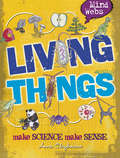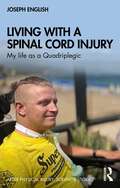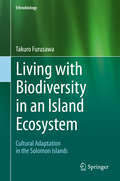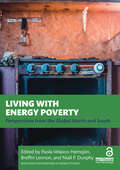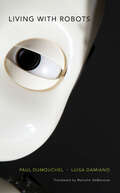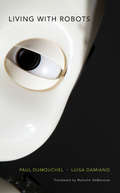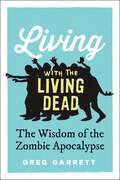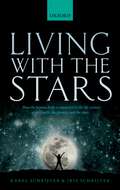- Table View
- List View
Living Things (Mind Webs #2)
by Anna ClaybourneMind Webs is an inspiring, visually exciting, series which will make science make sense. A mind web is a way of putting all of the key information about a topic on one page. Each book contains 12 mind webs, each beautifully illustrated with pictures and diagrams, showing how the information about each topic links together in a truly fascinating way. Whether you want to gain a better understanding of science, or whether you need to revise a topic, these books will give you the full picture, helping you to sort out, learn and remember key science concepts, facts and ideas. Includes advice on how to make your own mind web and a full glossary to extend your scientific vocabulary. The Living Things title has mind webs on: living things, cells, life processes, animals, animal life cycles, plants, plant life cycles, fungi, micro-organisms, habitats, adaptation, genes and DNA.
Living Together: The Biology of Animal Parasitism
by W. TragerWilliam Trager has been an avid student of parasites for over 50 years at the Rockefeller University. Around the turn of this century, parasitology enjoyed a certain vogue, inspired by colonial responsibilities of the technically ad vanced countries, and by the exciting etiological and therapeutic discoveries of Ross, Manson, Ehrlich, and others. For some decades, the Western hemi sphere's interest in animal parasites has been eclipsed by concern for bacteria and viruses as agents of transmissible disease. Only very recently, initiatives like the Tropical Disease Research programs of WHO-World Bank-UNDP, and the Great Neglected Disease networks of the Rockefeller and MacArthur Foundations have begun to compensate for the neglect of these problems by United States federal health research agencies. Throughout that period, how ever, the Rockefeller Institute (later University) has given high priority to the challenges of parasitism, corresponding during a formidable period with Dr. Trager's own career. The present work then, is a distillation of the insight collected by our principal doyen of parasite biology, informed but by no means confined to his own research. It is addressed to the reader of broad biological interest and training, not to the specialist. The disarmingly unpretentious style makes the work readily accessible to college undergraduates or even to gifted high school students; but do not be deceived thereby, as it has an enormous range of factual information and theoretical insight, familiar to few, but potentially important to most biologists.
Living with a Spinal Cord Injury: My life as a Quadriplegic
by Joseph EnglishJoseph English was living his best life when a car accident changed everything. He suffered life changing injuries, and the doctors told him there was no chance of recovery. Facing life as a quadriplegic, Joe lost his business, his romantic partner, and, for a while, his will to carry on. His story, told with extensive contributions from his family and friends, charts his journey from being dead at the roadside to finding something to live for as he recounts his progress from injury to survival. With absolute candour, Joe tells the whole story of his accident, his rehabilitation, and his recovery. Full of advice and suggestions from professionals in the rehabilitation journey, this book is remarkably frank about the struggles Joe has endured, and the times when he felt as if life wasn’t worth living. It addresses all the most difficult issues around life after paralysis, including loss of identity and letting go of the past, as well as providing practical information on topics such as assistive technology, financial claims and legal support. It also outlines the various roles of those in the rehabilitation team. His doctors and specialist practitioners give their unique perspectives into their processes and procedures, helping to demystify them, while Joe’s family and friends ask the kinds of questions readers will be asking too, making this an invaluable guide to what to expect for anyone going through a similar experience. The book shows – by lived example – that there is always more to live for. It is essential reading for those with paraplegia, quadriplegia and other spinal injuries, and their families, friends and care-givers. It is also valuable for neuropsychologists, neurologists and other rehabilitation therapists, as well as students in medicine, nursing, allied health and neuropsychology.
Living with a Spinal Cord Injury: My life as a Quadriplegic
by Joseph EnglishJoseph English was living his best life when a car accident changed everything. He suffered life changing injuries, and the doctors told him there was no chance of recovery. Facing life as a quadriplegic, Joe lost his business, his romantic partner, and, for a while, his will to carry on. His story, told with extensive contributions from his family and friends, charts his journey from being dead at the roadside to finding something to live for as he recounts his progress from injury to survival. With absolute candour, Joe tells the whole story of his accident, his rehabilitation, and his recovery. Full of advice and suggestions from professionals in the rehabilitation journey, this book is remarkably frank about the struggles Joe has endured, and the times when he felt as if life wasn’t worth living. It addresses all the most difficult issues around life after paralysis, including loss of identity and letting go of the past, as well as providing practical information on topics such as assistive technology, financial claims and legal support. It also outlines the various roles of those in the rehabilitation team. His doctors and specialist practitioners give their unique perspectives into their processes and procedures, helping to demystify them, while Joe’s family and friends ask the kinds of questions readers will be asking too, making this an invaluable guide to what to expect for anyone going through a similar experience. The book shows – by lived example – that there is always more to live for. It is essential reading for those with paraplegia, quadriplegia and other spinal injuries, and their families, friends and care-givers. It is also valuable for neuropsychologists, neurologists and other rehabilitation therapists, as well as students in medicine, nursing, allied health and neuropsychology.
Living with Biodiversity in an Island Ecosystem: Cultural Adaptation in the Solomon Islands (Ethnobiology #0)
by Takuo FurusawaThis book presents a detailed case study of ecological and cultural interactions between the people and their natural environment at Roviana Lagoon, Solomon Islands, a land of rich biodiversity. This volume documents the subsistence lifestyle of the people and their indigenous ecological knowledge, analyzes the effects of recent socioeconomic changes on the people and ecosystem, and proposes future directions for sustainability. The contents have been designed to answer questions such as, “What kinds of factors have determined whether current human actions are sustainable or will result in a collapse of biocultural diversity in the Solomon Islands?”; “How do Solomon Islanders recognize nature and biodiversity conservation in traditional ways or under socioeconomic changes?”; and “How can harmony between humans and nature be achieved in the Solomon Islands under changing socioeconomic conditions?” A truly transdisciplinary approach is applied, integrating theories of human ecology, quantitative ethnobiology, and folk ecology and methods of vegetation surveys, ethnographic fieldwork, remote sensing, and health surveys, in order to link different domains of humans and the natural world. In addition, this work focuses on the importance of understanding of diversity not only in natural environments, but also in human societies, and will be a valuable source for many, especially ecologists, anthropologists, conservation practitioners, and rural development planners.
Living with Brain Injury
by Philip FaircloughOn November 7th 1994, Philip Fairclough fell fifteen feet from a ladder onto a concrete patio. The impact caused massive trauma to his head and the subsequent brain damage he suffered has radically changed his life. At first unable to dress himself, cross roads on his own or tell the time, Philip underwent an intensive course of rehabilitation and occupational therapy, which slowly restored many of the lost skills that he had once taken for granted. His account tells of the hurdles he faced and overcame while in residence at a rehabilitation centre, the difficulties of readapting to family life, and finally the emergence of his new vocation as a writer. Like most of us, Philip never expected that severe injury would happen to him - but from the first he decided not to give up. His courage, determination and the support of his family characterize this account, which interweaves his own story with practical information about brain injury. Members of the medical profession, physiotherapists, occupational therapists and counsellors will all find this account helpful and revealing - as will people affected personally by brain injury, and their families and friends.
Living with Brain Injury (PDF)
by Philip FaircloughOn November 7th 1994, Philip Fairclough fell fifteen feet from a ladder onto a concrete patio. The impact caused massive trauma to his head and the subsequent brain damage he suffered has radically changed his life. At first unable to dress himself, cross roads on his own or tell the time, Philip underwent an intensive course of rehabilitation and occupational therapy, which slowly restored many of the lost skills that he had once taken for granted. His account tells of the hurdles he faced and overcame while in residence at a rehabilitation centre, the difficulties of readapting to family life, and finally the emergence of his new vocation as a writer. Like most of us, Philip never expected that severe injury would happen to him - but from the first he decided not to give up. His courage, determination and the support of his family characterize this account, which interweaves his own story with practical information about brain injury. Members of the medical profession, physiotherapists, occupational therapists and counsellors will all find this account helpful and revealing - as will people affected personally by brain injury, and their families and friends.
Living with Darwin: Evolution, Design, and the Future of Faith (Philosophy in Action)
by Philip KitcherCharles Darwin has been at the center of white-hot public debate for more than a century. In Living With Darwin, Philip Kitcher stokes the flames swirling around Darwin's theory, sifting through the scientific evidence for evolution, Creation Science, and Intelligent Design, and revealing why evolution has been the object of such vehement attack. Kitcher first provides valuable perspective on the present controversy, describing the many puzzles that blocked evolution's acceptance in the early years, and explaining how scientific research eventually found the answers to these conundrums. Interestingly, Kitcher shows that many of these early questions have been resurrected in recent years by proponents of Intelligent Design. In fact, Darwin himself considered the issue of intelligent design, and amassed a mountain of evidence that effectively refuted the idea. Kitcher argues that the problem with Intelligent Design isn't that it's "not science," as many critics say, but that it's "dead science," raising questions long resolved by scientists. But Kitcher points out that it is also important to recognize the cost of Darwin's success--the price of "life with Darwin." Darwinism has a profound effect on our understanding of our place in the universe, on our religious beliefs and aspirations. It is in truth the focal point of a larger clash between religious faith and modern science. Unless we can resolve this larger issue, the war over evolution will go on.
Living with Darwin: Evolution, Design, and the Future of Faith (Philosophy in Action)
by Philip KitcherCharles Darwin has been at the center of white-hot public debate for more than a century. In Living With Darwin, Philip Kitcher stokes the flames swirling around Darwin's theory, sifting through the scientific evidence for evolution, Creation Science, and Intelligent Design, and revealing why evolution has been the object of such vehement attack. Kitcher first provides valuable perspective on the present controversy, describing the many puzzles that blocked evolution's acceptance in the early years, and explaining how scientific research eventually found the answers to these conundrums. Interestingly, Kitcher shows that many of these early questions have been resurrected in recent years by proponents of Intelligent Design. In fact, Darwin himself considered the issue of intelligent design, and amassed a mountain of evidence that effectively refuted the idea. Kitcher argues that the problem with Intelligent Design isn't that it's "not science," as many critics say, but that it's "dead science," raising questions long resolved by scientists. But Kitcher points out that it is also important to recognize the cost of Darwin's success--the price of "life with Darwin." Darwinism has a profound effect on our understanding of our place in the universe, on our religious beliefs and aspirations. It is in truth the focal point of a larger clash between religious faith and modern science. Unless we can resolve this larger issue, the war over evolution will go on.
Living with Dementia: Neuroethical Issues and International Perspectives (Advances in Neuroethics)
by Veljko Dubljević Frances BottenbergThis book addresses current issues in the neuroscience and ethics of dementia care, including philosophical as well as ethical legal, and social issues (ELSIs), issues in clinical, institutional, and private care-giving, and international perspectives on dementia and care innovations. As such, it is a must-read for anyone interested in a well-researched, thought-provoking overview of current issues in dementia diagnosis, care, and social and legal policy. All contributions reflect the latest neuroscientific research on dementia, either broadly construed or in terms of the etiologies and symptoms of particular forms of dementia. Given its interdisciplinary and international scope, its depth of research, and its qualitative emphasis, the book represents a valuable addition to the available literature on neuroethics, gerontology, and neuroscientific memory research.
Living with Drugs
by Alessandro Stella Anne CoppelLiving with Drugs explores topics surrounding their control, use and risk of misuse. The conclusions in this book are drawn from the seminar held at the EHESS in Paris during the years 2015-2017. It involved anthropologists, sociologists, historians, philosophers, economists, lawyers, doctors, psychiatrists, health center workers, community activists, users and former drug users. The seminar, like the resulting book, is based on a transversal approach to disciplines, space and time, and a confluence of academic, practical and experiential knowledge.Details the progress of French research and public debates on French and international drug policyIncludes the input of human and social sciences and the expertise of health professionals and activists
Living with Energy Poverty: Perspectives from the Global North and South (Routledge Explorations in Energy Studies)
by Paola Velasco-Herrejón Breffní Lennon Niall P. DunphyLiving with Energy Poverty: Perspectives from the Global North and South expands our collective understanding of energy poverty and deepens our recognition of the phenomenon by engaging with the lived experiences of energy-poor households across different contexts.Understanding the lived experience of energy poverty is an essential component in the design of any effort to alleviate what is fundamentally a deep-rooted, multi-faceted, wickedly complex problem. This requires a nuanced understanding of the causal factors and the research methods that can respond to the flexible spatial and temporal nature of the condition, as well as its wellbeing and justice implications. Drawing together the expertise and connectedness of authors from the Global South and North, this book presents novel approaches to understanding the often hidden forms of domestic energy deprivation. Case studies from 20 countries provide critical perspectives on this phenomenon while analysing the policy practices, government strategy, and sustainability implications of divergent manifestations. The book takes a multidimensional perspective, challenging the bias towards energy production and service provision, which often do not align with the aspirations and realities of energy households across global contexts, thus facilitating a useful dialogue on the nature of energy poverty.The book is a timely source for policymakers, practitioners, and scholars seeking fresh, diverse insights into the everyday reality of energy poverty and wanting to better understand the challenges a people-centred, just energy transition can present.Chapter 1 of this book is freely available as a downloadable Open Access PDF at http://www.taylorfrancis.com under a Creative Commons [Attribution-Non Commercial-No Derivatives (CC-BY-NC-ND)] 4.0 license.Chapter 2 of this book is freely available as a downloadable Open Access PDF at http://www.taylorfrancis.com under a Creative Commons [Attribution-Non Commercial-No Derivatives (CC-BY-NC-ND)] 4.0 license.Chapter 22 of this book is freely available as a downloadable Open Access PDF at http://www.taylorfrancis.com under a Creative Commons [Attribution-Non Commercial-No Derivatives (CC-BY-NC-ND)] 4.0 license.
Living with Energy Poverty: Perspectives from the Global North and South (Routledge Explorations in Energy Studies)
Living with Energy Poverty: Perspectives from the Global North and South expands our collective understanding of energy poverty and deepens our recognition of the phenomenon by engaging with the lived experiences of energy-poor households across different contexts.Understanding the lived experience of energy poverty is an essential component in the design of any effort to alleviate what is fundamentally a deep-rooted, multi-faceted, wickedly complex problem. This requires a nuanced understanding of the causal factors and the research methods that can respond to the flexible spatial and temporal nature of the condition, as well as its wellbeing and justice implications. Drawing together the expertise and connectedness of authors from the Global South and North, this book presents novel approaches to understanding the often hidden forms of domestic energy deprivation. Case studies from 20 countries provide critical perspectives on this phenomenon while analysing the policy practices, government strategy, and sustainability implications of divergent manifestations. The book takes a multidimensional perspective, challenging the bias towards energy production and service provision, which often do not align with the aspirations and realities of energy households across global contexts, thus facilitating a useful dialogue on the nature of energy poverty.The book is a timely source for policymakers, practitioners, and scholars seeking fresh, diverse insights into the everyday reality of energy poverty and wanting to better understand the challenges a people-centred, just energy transition can present.Chapter 1 of this book is freely available as a downloadable Open Access PDF at http://www.taylorfrancis.com under a Creative Commons [Attribution-Non Commercial-No Derivatives (CC-BY-NC-ND)] 4.0 license.Chapter 2 of this book is freely available as a downloadable Open Access PDF at http://www.taylorfrancis.com under a Creative Commons [Attribution-Non Commercial-No Derivatives (CC-BY-NC-ND)] 4.0 license.Chapter 22 of this book is freely available as a downloadable Open Access PDF at http://www.taylorfrancis.com under a Creative Commons [Attribution-Non Commercial-No Derivatives (CC-BY-NC-ND)] 4.0 license.
Living with Enza: The Forgotten Story of Britain and the Great Flu Pandemic of 1918 (Macmillan Science)
by M. Honigsbaum'Never since the Black Death has such a plague swept over the face of the world,' commented the Times , '[and] never, perhaps, has a plague been more stoically accepted.' When the Great Influenza pandemic finally ended, in April 1919, 228,000 people in Britian alone were dead. This book tells the story of the Great Influenza pandemic.
Living with Our Sun’s Ultraviolet Rays
by Arthur C. GieseSunlight is part of everyday life and we accept it as good-and good it is in a number of ways. The sun is our source of warmth, and of the light by which we see. It is, in fact, the source of the energy with which life continues on earth. It furnishes energy for photosynthesis, and the pro ducts of photosynthesis constitute our food, building materials, and fuel. A steady state of balance and fine interrelationships exists between life on earth and all the forces and stresses in nature. This book will pin point the balance and relationships we share with sunlight. Our primary focus will be on the ultraviolet radiation of the sun, and on the ultraviolet photobiology of life on earth. This is the story of the effects of the sun's ultraviolet radiation, both good and bad, on all of us and all of life. We will explore the nature of the sun's ultraviolet radiation as it reaches the earth's surface today, and as it probably affected the earth in the distant past; and examine the effect of such radiation on all life, unicellular organisms as well as multicellular plants and animals. The effects of the sun's ultraviolet rays are primarily a result of their action upon cells, and secondarily, a result of their interactions between cells. The cell of a multicellular organism-man included-is also part of the tissue of an organ, and the organ is part of the whole organism.
Living with Robots
by Paul DumouchelLiving with Robots recounts a foundational shift in robotics, from artificial intelligence to artificial empathy, and foreshadows an inflection point in human evolution. As robots engage with people in socially meaningful ways, social robotics probes the nature of the human emotions that social robots are designed to emulate.
Living with Robots
by Paul DumouchelLiving with Robots recounts a foundational shift in robotics, from artificial intelligence to artificial empathy, and foreshadows an inflection point in human evolution. As robots engage with people in socially meaningful ways, social robotics probes the nature of the human emotions that social robots are designed to emulate.
Living with the Earth: Concepts in Environmental Health Science
by Gary S. MooreIncludes all the bells and whistles you and your students have come to expect It's hard to imagine a book more innovative and groundbreaking than Living with the Earth: Concepts in Environmental Health Science, Third Edition. The first edition won the CHOICE award for Outstanding Academic Book and both previous editions became bestsellers in their
Living with the Earth, Fourth Edition: Concepts in Environmental Health Science
by Gary S. Moore Kathleen A. BellShelving Guide; Environmental ScienceThis is a groundbreaking and innovative book now in its fourth edition. The first edition won the CHOICE award for outstanding Academic Book while editions two and three became bestsellers on their own right. This fourth edition is packed with new updates on current world events associated with environmental issues and related health concerns. The author maintains traditional concepts and merges them with new and controversial issues. The book has been revised to include up-to-date topics with and a revised Web site with updated links.So what Coverage of emergency preparedness for environmental health practitioners Discussion of population dynamics especially with regard to overpopulation and underpopulation around the world and their respective influences on social, economic, and environmental concerns. The mechanisms of environmental disease, emphasizing genetic disease and its role in developmental disorders and cancer. Human behaviors and pollution are presented along with respect to their roles in cancer risk. The ever increasing issues surrounding emerging and re-emerging diseases around the earth and the introduction of an increasing number of emerging diseases. The growing problems of asthma and other health effects associated with air pollution. An exploration of the mechanisms of toxicity with special reference to the immune system and endocrine disruption. The ongoing issues of the creation and disposal of hazardous waste along with the controversies surrounding disposal are presented. The issues and benefits of recycling are explored. The use of HACCP in assuring food quality, food safety issues, and the Food Quality Protection Act are discussed. Numerous technical illustrations, charts, graphs, and photographs are included What on the Web? Test bank and study questions giving a complete review of the concepts covered. Search tools for online journals and databases covering useful, up-to-date information in health and environmental topics Subject specific links by chapter as well as Federal, state, and organization sites with relevant information Downloadable PowerPoint files for each Chapter providing the instructor with ready-made presentation materials that can be modified as needed. Downloadable and printable test questions and answers for each chapter available to instructors
Living with the Earth, Fourth Edition: Concepts in Environmental Health Science
by Gary S. Moore Kathleen A. BellShelving Guide; Environmental ScienceThis is a groundbreaking and innovative book now in its fourth edition. The first edition won the CHOICE award for outstanding Academic Book while editions two and three became bestsellers on their own right. This fourth edition is packed with new updates on current world events associated with environmental issues and related health concerns. The author maintains traditional concepts and merges them with new and controversial issues. The book has been revised to include up-to-date topics with and a revised Web site with updated links.So what Coverage of emergency preparedness for environmental health practitioners Discussion of population dynamics especially with regard to overpopulation and underpopulation around the world and their respective influences on social, economic, and environmental concerns. The mechanisms of environmental disease, emphasizing genetic disease and its role in developmental disorders and cancer. Human behaviors and pollution are presented along with respect to their roles in cancer risk. The ever increasing issues surrounding emerging and re-emerging diseases around the earth and the introduction of an increasing number of emerging diseases. The growing problems of asthma and other health effects associated with air pollution. An exploration of the mechanisms of toxicity with special reference to the immune system and endocrine disruption. The ongoing issues of the creation and disposal of hazardous waste along with the controversies surrounding disposal are presented. The issues and benefits of recycling are explored. The use of HACCP in assuring food quality, food safety issues, and the Food Quality Protection Act are discussed. Numerous technical illustrations, charts, graphs, and photographs are included What on the Web? Test bank and study questions giving a complete review of the concepts covered. Search tools for online journals and databases covering useful, up-to-date information in health and environmental topics Subject specific links by chapter as well as Federal, state, and organization sites with relevant information Downloadable PowerPoint files for each Chapter providing the instructor with ready-made presentation materials that can be modified as needed. Downloadable and printable test questions and answers for each chapter available to instructors
Living with the Living Dead: The Wisdom of the Zombie Apocalypse
by Greg GarrettWhen humankind faces what it perceives as a threat to its very existence, a macabre thing happens in art, literature, and culture: corpses begin to stand up and walk around. The dead walked in the fourteenth century, when the Black Death and other catastrophes roiled Europe. They walked in images from World War I, when a generation died horribly in the trenches. They walked in art inspired by the Holocaust and by the atomic attacks on Japan. Now, in the early twenty-first century, the dead walk in stories of the zombie apocalypse, some of the most ubiquitous narratives of post-9/11 Western culture. Zombies appear in popular movies and television shows, comics and graphic novels, fiction, games, art, and in material culture including pinball machines, zombie runs, and lottery tickets. The zombie apocalypse, Greg Garrett shows us, has become an archetypal narrative for the contemporary world, in part because zombies can stand in for any of a variety of global threats, from terrorism to Ebola, from economic uncertainty to ecological destruction. But this zombie narrative also brings us emotional and spiritual comfort. These apocalyptic stories, in which the world has been turned upside down and protagonists face the prospect of an imminent and grisly death, can also offer us wisdom about living in a community, present us with real-world ethical solutions, and invite us into conversation about the value and costs of survival. We may indeed be living with the living dead these days, but through the stories we consume and the games we play, we are paradoxically learning what it means to be fully alive.
Living with the Living Dead: The Wisdom of the Zombie Apocalypse
by Greg GarrettWhen humankind faces what it perceives as a threat to its very existence, a macabre thing happens in art, literature, and culture: corpses begin to stand up and walk around. The dead walked in the fourteenth century, when the Black Death and other catastrophes roiled Europe. They walked in images from World War I, when a generation died horribly in the trenches. They walked in art inspired by the Holocaust and by the atomic attacks on Japan. Now, in the early twenty-first century, the dead walk in stories of the zombie apocalypse, some of the most ubiquitous narratives of post-9/11 Western culture. Zombies appear in popular movies and television shows, comics and graphic novels, fiction, games, art, and in material culture including pinball machines, zombie runs, and lottery tickets. The zombie apocalypse, Greg Garrett shows us, has become an archetypal narrative for the contemporary world, in part because zombies can stand in for any of a variety of global threats, from terrorism to Ebola, from economic uncertainty to ecological destruction. But this zombie narrative also brings us emotional and spiritual comfort. These apocalyptic stories, in which the world has been turned upside down and protagonists face the prospect of an imminent and grisly death, can also offer us wisdom about living in a community, present us with real-world ethical solutions, and invite us into conversation about the value and costs of survival. We may indeed be living with the living dead these days, but through the stories we consume and the games we play, we are paradoxically learning what it means to be fully alive.
Living with the Stars: How the Human Body is Connected to the Life Cycles of the Earth, the Planets, and the Stars
by Iris Schrijver Karel SchrijverLiving with the Stars tells the fascinating story of what truly makes the human body. The body that is with us all our lives is always changing. We are quite literally not who we were years, weeks, or even days ago: our cells die and are replaced by new ones at an astonishing pace. The entire body continually rebuilds itself, time and again, using the food and water that flow through us as fuel and as construction material. What persists over time is not fixed but merely a pattern in flux. We rebuild using elements captured from our surroundings, and are thereby connected to animals and plants around us, and to the bacteria within us that help digest them, and to geological processes such as continental drift and volcanism here on Earth. We are also intimately linked to the Sun's nuclear furnace and to the solar wind, to collisions with asteroids and to the cycles of the birth of stars and their deaths in cataclysmic supernovae, and ultimately to the beginning of the universe. Our bodies are made of the burned out embers of stars that were released into the galaxy in massive explosions billions of years ago, mixed with atoms that formed only recently as ultrafast rays slammed into Earth's atmosphere. All of that is not just remote history but part of us now: our human body is inseparable from nature all around us and intertwined with the history of the universe.
Living with the Stars: How the Human Body is Connected to the Life Cycles of the Earth, the Planets, and the Stars
by Karel Schrijver Iris SchrijverLiving with the Stars tells the fascinating story of what truly makes the human body. The body that is with us all our lives is always changing. We are quite literally not who we were years, weeks, or even days ago: our cells die and are replaced by new ones at an astonishing pace. The entire body continually rebuilds itself, time and again, using the food and water that flow through us as fuel and as construction material. What persists over time is not fixed but merely a pattern in flux. We rebuild using elements captured from our surroundings, and are thereby connected to animals and plants around us, and to the bacteria within us that help digest them, and to geological processes such as continental drift and volcanism here on Earth. We are also intimately linked to the Sun's nuclear furnace and to the solar wind, to collisions with asteroids and to the cycles of the birth of stars and their deaths in cataclysmic supernovae, and ultimately to the beginning of the universe. Our bodies are made of the burned out embers of stars that were released into the galaxy in massive explosions billions of years ago, mixed with atoms that formed only recently as ultrafast rays slammed into Earth's atmosphere. All of that is not just remote history but part of us now: our human body is inseparable from nature all around us and intertwined with the history of the universe.
Living With the Trees of Life: A Practical Guide to Rebooting the Planet through Tropical Agriculture and Putting Farmers First
by Roger LeakeyWith our world torn by climate change, deforestation, land degradation, hunger, malnutrition, poverty, loss of wildlife habitat, zoonotic pandemics, illegal migration and social injustice, this book seeks to find a practical and pragmatic way forwards. Based on the author's extensive experience of tropical agriculture and forestry around the world, as well as his combination of practical and academic agricultural qualifications, the second edition of Living with the Trees of Life presents a unique and positive perspective on resolving these big global issues. It aims to identify principles, strategies, techniques, and skills to find a path through the maze of options for sustainable living in the tropics and subtropics. The book specifically draws heavily on a single case study which involved working to resolve the failure of tropical and subtropical agriculture to feed, sustain and support the needs of rural communities. To address the 'big picture' facing society, the work identified the traditionally important indigenous trees of tropical ecosystems - the trees of life - as a missing component of farming systems. These trees are keystones of the natural environment. Their products and critical ecological and social services have been overlooked by modern agriculture and should be recognized as the natural capital of the environment providing the very many day-to-day needs of local people. Many of today's big problems can be traced back to the breakdown of the natural, social and human capital of farming systems. Hence, a focus on restoring the natural capital also has important benefits for the livelihoods of the rural population, as well as for the productivity of the agroecosystem. However, the real potential is to go much further and to build new natural capital in the form of new socially-modified tree crops producing a very wide range of food, medicinal and other non-food products for new local business enterprises. This then restores the degraded social and human capital and starts to create new physical and financial capitals much needed for employment and economic development. There is, however, a missing 6th capital - the political and social will to change the way we manage our world by re-booting tropical agriculture and putting the needs of local people at the forefront of farming systems. Drawing on the technologies from across the spectrum of current conventional approaches to agricultural production, Living with the Trees of Life seeks to promote the adoption of a new way ahead - described as Land Maxing - that also increases the returns on past investments in agriculture. The target readership of this book is a wide and diverse array of people engaged in advocating and/or adopting ways to address the issues affecting our divided and dysfunctional world, before it is too late. Written in an accessible and engaging style, this book tells the story of how a new area of crop science has emerged across the tropics to create highly nutritious crops which can enhance food security and start to address the big issues facing humanity. Thus, this book is a vital read for academics, policy makers, and the environmentally and socially aware public alike.
